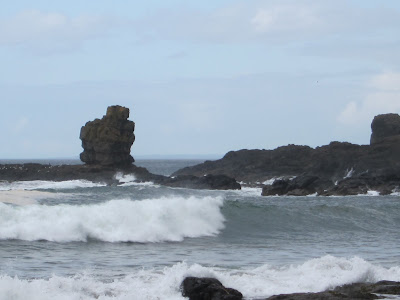First, my sincere apologies for not having posted for so long. When I was in Sligo for two weeks, I had very limited internet access, and couldn't really post. I had a great two weeks at the Yeats Summer School, but more on that in the next post. First, my trip to Galway.
Galway is a very quaint city- almost a big town. It's artsy and is very much a college town. I was there during the Galway Arts Festival, which is the largest arts festival in Ireland, so the city was bustling with activity- students, tourists, lots of street performers, etc.
Kennedy Park, located in Eyre Square, is one of the main gathering spaces in the city.

Galway is also very much a medieval city, and at one point there were fourteen tribes or families that dominated the social and economic life of the city. Each had their own coat of arms, and their flags still fly in Eyre Square...
A sculpture of the "Galway Hooker"- no, not a woman of the night, but a traditional sailing boat built to withstand the rough Irish seas.
I went on a free walking tour of the city, which is where I learned these tidbits about hookers and tribes. Along the way, we ran into this sculpture of Oscar Wilde.
A medievaly street, although most of the streets were windier...
Nora Barnacle, wife of James Joyce, was from Galway. The Nora Barnacle House, according to my tour guide, is the smallest museum in Ireland.
A nice walk along the river, with one of the festival tents in the background.
The bridge to Galway Cathedral.
The townhouses along Galway Bay.
I saw several shows at the festival. The most memorable was 'Penelope,' a new play by Irish playwright Enda Walsh at Druid Theatre Company. Druid is perhaps Ireland's most well-known theatre company, and the first to produce several of McDonagh's plays, so to finally see a performance at the Druid Lane Theatre was particularly exciting for me and fit in well with my research.
I also saw this intense dance piece called 'Political Mother,' choreographed by Hofesh Schechter, an Israeli choreographer based in the U.K. It began with a spotlight on a guy dressed in full samurai garb committing seppuku. The ushers gave out ear plugs as we entered, since the piece was extremely loud and percussion heavy. The lighting was very dynamic, allowing the space to morph in interesting ways as the dancers performed in many differently shaped areas on multiple levels of the stage. I snapped a picture of the final look after the performance:
During my stay in Galway, I also met with Louis de Paor, an Irish-language poet, to talk about his poetry and issues of translation, as well as with Patrick Lonergan, an Irish drama scholar and critic. Both are professors at NUI Galway and both were very friendly and gracious in talking to me. Patrick directed the Synge Summer School, and my meeting with him was incredibly valuable, since he is writing a book on McDonagh. He pointed me in several good directions, and I left our conversation, and Galway, with lots to think about.
























































